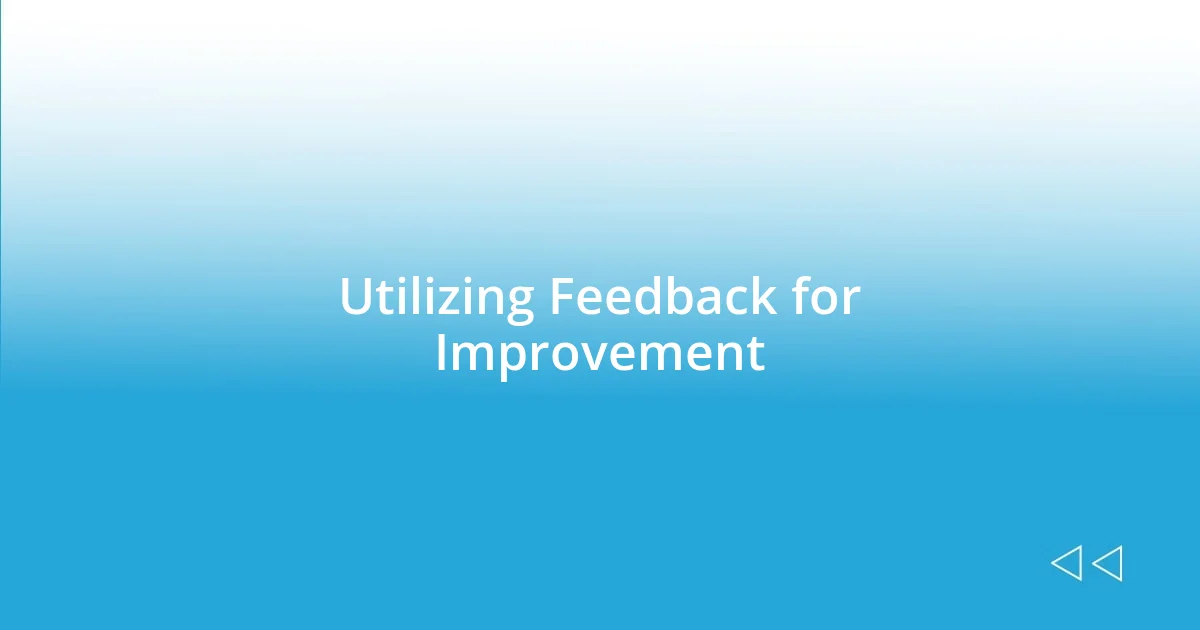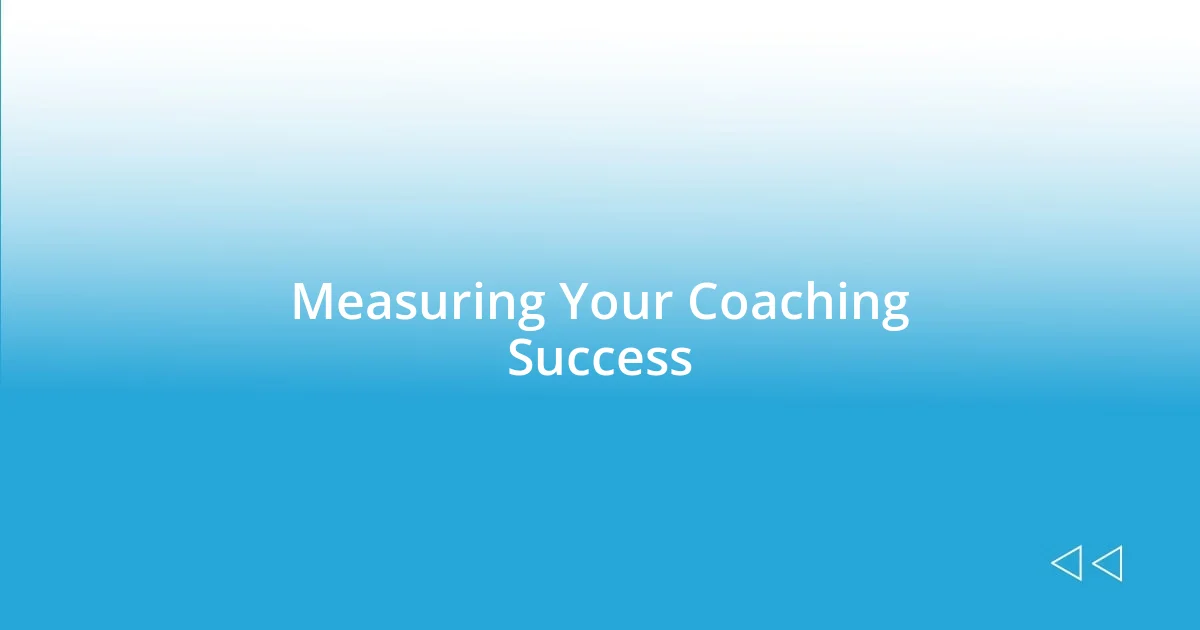Key takeaways:
- Clarity in coaching is essential for fostering meaningful connections and defining specific goals that resonate with clients.
- Recognizing personal challenges, such as perfectionism and fear of inadequacy, enhances empathy and supports client progress.
- Utilizing feedback and embracing adaptability in coaching strategies are crucial for ongoing improvement and collaborative client relationships.

Understanding Coaching Clarity
Clarity in coaching is an essential element that shapes the entire coaching experience. I remember a time when I felt lost in a coaching session, both for myself and the client. It dawned on me then: without clarity, we were merely spinning our wheels. Have you ever felt that frustration in your own experiences? It’s like trying to navigate a foggy road without headlights.
When I finally took the time to define specific goals and outcomes with my clients, our sessions transformed. This focused approach allowed us to dig deeper into their personal aspirations and barriers. I learned that clarity is not just about setting goals; it’s about cultivating a shared understanding between the coach and the client, a bond that makes progress possible.
I often ask myself and my clients, “What does success look like for you?” This reflection fosters a deeper connection and paves the way for meaningful breakthroughs. It was in those moments of honest reflection that I witnessed clarity evolve into a powerful catalyst for change. Isn’t it incredible how a simple question can unlock a whole new level of understanding?

Recognizing Personal Challenges
Recognizing personal challenges can often feel like a daunting task. I vividly remember a coaching session where I grappled with my need for perfection. I was so focused on helping my client that I neglected to address my own insecurities. This realization hit me hard; the moment I acknowledged my struggles, I began to see the paths to improvement, both for myself and my clients.
In my experience, overcoming these challenges starts with self-awareness. I discovered that reflecting on my feelings during sessions often revealed underlying fears of inadequacy. Each time I faced these emotions, I gained insights that enriched my coaching practice. It’s like peeling back layers of an onion; each layer brings me closer to understanding not just myself, but also the challenges my clients face.
Identifying these personal hurdles is essential for growth. When I embraced my vulnerabilities, I noticed a shift in my approach. I could empathize with my clients on a deeper level, fostering a supportive environment that encouraged them to explore their own challenges. Have you ever felt the power of shared vulnerability in a coaching relationship? It can create remarkable connections and drive significant progress.
| Personal Challenge | Impact on Coaching |
|---|---|
| Perfectionism | Made me hesitant to acknowledge my own limitations, affecting the guidance I provided. |
| Fear of Inadequacy | Limited my ability to connect with clients meaningfully, hindering their growth. |
| Vulnerability | Enhanced my empathy and understanding, creating stronger bonds with clients. |

Defining Your Coaching Goals
Defining your coaching goals is a pivotal step in creating a path toward clarity. I remember when I first approached goal-setting with my clients. Instead of simply listing objectives, I encouraged them to visualize their desired outcomes. This shift changed everything. We would sit down together and explore what truly mattered to them, and I saw how their eyes lit up with excitement. It was in those discussions that we sculpted goals that resonated deeply, turning vague aspirations into tangible targets.
To effectively define coaching goals, consider these key points:
- Specificity: Ensure goals are clear and detailed. Instead of saying, “I want to improve my career,” try “I aim to secure a leadership position in my company within the next year.”
- Measurable Outcomes: Establish criteria to track progress. Think about how you can quantify success, such as “I will complete three networking events in the next three months.”
- Achievable Steps: Set realistic goals that encourage growth without overwhelming. Maybe it’s dedicating an hour a week to skill development.
- Relevance: Align your goals with your personal values and aspirations. This ensures motivation stays high.
- Time-Bound: Create deadlines to maintain momentum. Knowing there’s a time frame fosters urgency and focus.
Embracing this structured approach has made a world of difference for me and my clients. The process isn’t just about filtering through desires; it’s about igniting passion. Seeing someone discover their true ambitions is incredibly rewarding. Have you ever had a moment where everything just clicked? That’s where the magic of goal-setting truly lies.

Utilizing Feedback for Improvement
Utilizing feedback is crucial in the coaching journey. I once had a client who was reluctant to share their thoughts on our sessions, fearing it might hurt my feelings. I encouraged them to be open, emphasizing that their honest feedback was a tool for my growth as a coach. When they finally shared their perspective, I discovered areas where I could improve, which ultimately enhanced our coaching relationship. Can you imagine the difference it makes when both coach and client feel safe to express their thoughts?
Feedback isn’t just a one-way street; it’s a dynamic exchange. I often ask my clients for their thoughts on specific exercises or approaches we’ve tried. Their insights not only guide me but also empower them. One client, for instance, expressed how a particular technique felt off for them. Rather than feeling defensive, I welcomed the input. It led us to adapt our strategy, enabling them to feel more in control of their growth. Have you ever realized that the best insights sometimes come from those we serve?
Moreover, I incorporate regular feedback sessions into my practice to reflect on our progress together. These moments have been transformative, turning what could feel like a static relationship into a collaborative partnership. For me, it’s like tuning an instrument; each piece of feedback helps strike a better chord in our work together. By encouraging this dialogue, I invite clients to take part in their own journey actively. How has feedback influenced your experiences in coaching? Embracing this process opens doors to continuous improvement for both coach and client.

Implementing Effective Coaching Strategies
Implementing effective coaching strategies is all about adaptability. I remember a time when one of my clients struggled with the rigid structure of our sessions. It wasn’t until I altered my approach—switching from a strict agenda to a more fluid conversation—that I saw real breakthroughs. This reminded me that sometimes, the best plans need to breathe. Have you faced moments where your approach just didn’t fit? Tweaking the strategy to align with a client’s energy can lead to profound change.
Collaboration is another essential strategy. I often invite clients to co-create their action plans, asking questions like, “Which steps resonate with you?” This not only empowers them but also fosters a sense of ownership over their journey. I recall a client who initially felt overwhelmed by a complex goal. By breaking it down together into manageable bites, I watched them turn anxiety into excitement. It’s empowering to realize that you’re not just along for the ride but actually navigating the path, isn’t it?
An essential part of my coaching is the practice of reiterating progress. I once had a client who was too focused on their future goals and overlooked the small victories along the way. I started a habit of celebrating their wins during each session, no matter how trivial they seemed. Witnessing their confidence blossom was a joy. Isn’t it incredible how recognizing small achievements can ignite further motivation? Implementing thoughtful strategies like these not only enhances the coaching experience but also builds lasting connections with clients.

Measuring Your Coaching Success
Measuring your coaching success requires a blend of qualitative insights and quantitative metrics. Personally, I track client progress using a combination of goal-setting tools and regular check-ins. One client of mine had set an ambitious goal to improve their public speaking skills. By breaking it down into smaller milestones and tracking improvements through video recordings of their speeches, we could visibly see their growth. Isn’t it fulfilling to witness that transformation documented on a timeline?
I also believe in the power of self-reflection as a measurement tool. I regularly assess my effectiveness by rating my sessions after each meeting with clients. This practice allows me to identify patterns—for instance, I realized that clients responded particularly well when I incorporated storytelling into our discussions. This insight not only shapes my future sessions but reinforces the idea that our methodologies evolve with experience. Have you ever considered how much your personal reflections can contribute to your overall growth?
Aligning success with client satisfaction is another important metric. I recall a moment when a client unexpectedly expressed their gratitude for the support I offered during a particularly challenging time. Their emotional breakthrough was a testament to my impact and underscored that the most significant achievements in coaching often extend beyond traditional metrics. It’s these heartfelt connections that truly define success for me. How do you measure emotional milestones in your coaching journey?

Continuing Your Coaching Journey
Continuing your coaching journey is a lifelong endeavor, and I’ve often found that it’s about remaining open to new experiences. One time, I attended a workshop that focused solely on mindfulness techniques. Although I initially thought of it as unrelated to my coaching practice, I realized that integrating mindfulness into sessions helped clients find their center. Have you ever discovered a resource that seemed off-track but ultimately revolutionized your approach?
I also emphasize the importance of regular peer feedback. I remember reaching out to a fellow coach after a particularly tough session with a client. Their fresh perspective on my communication style provided me with insights I hadn’t considered. It reminded me that there’s incredible value in collaboration, even with colleagues from different fields. This exchange prompted me to refine my techniques. How often do you engage with others to gather new ideas and perspectives on your coaching?
Lastly, nurturing a growth mindset is crucial. I sometimes find myself revisiting foundational coaching books that inspired me at the beginning of my journey. Each read brings new insights, often highlighting concepts that resonate differently at various stages of my career. Just the other day, I came across a passage about the power of resilience that struck me in ways it hadn’t years ago. Isn’t it fascinating how our understanding evolves? Embracing this continuous learning is what keeps the coaching journey vibrant and transformative.
















